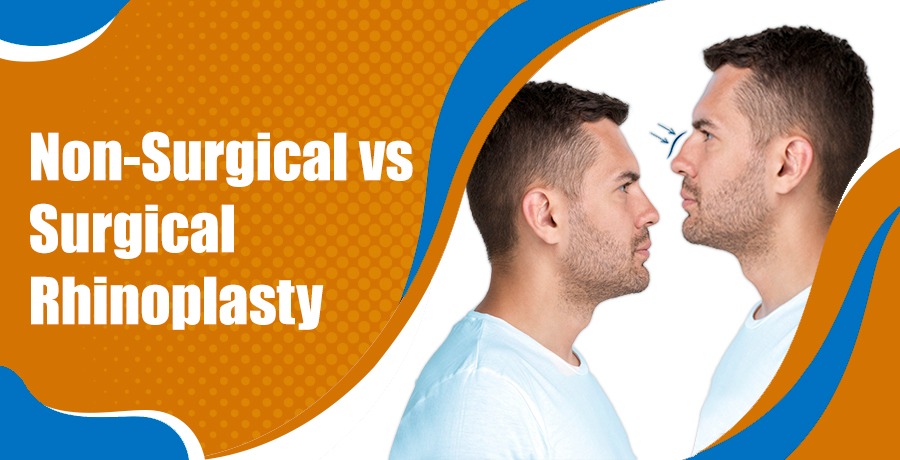
The nose is the center of your face, and it is very important for defining what your face looks like. Therefore, it is no wonder that it is one of the most common features that people want to change or improve upon. If you have been doing some research on how to improve the shape of your nose, you might have come across two different options: the traditional, permanent surgical route, or the newer, temporary "liquid nose job."
The question is, how do you know which option is right for you?
This guide is designed to explain the differences, advantages, and disadvantages of both surgical and non-surgical rhinoplasty, so you can make an informed choice.
The Gold Standard: Surgical Rhinoplasty
Surgical rhinoplasty, more commonly referred to as a nose job in Delhi, is an invasive surgical procedure. It is a proven, permanent method that changes the bone, cartilage, and tissue of your nose's framework to create a new, permanent shape.
How It Works
Rhinoplasty Surgery is performed by a plastic surgeon under general anaesthesia. Rhinoplasty Surgery involves incisions (either concealed on the inside of the nose or discreetly placed along the outside) to allow the surgeon access to the nasal framework.
The surgeon can then:
- Remove a bump (or dorsal hump) by safely shaving bone and cartilage.
- Make the nose smaller or narrower.
- Refine the tip from being bulbous or droopy.
- Straighten a crooked nose.
- Fix functional issues, such as a deviated septum, to allow for better breathing.
The Pros
-
Lasting Results: This is a one-and-done procedure. Changes are permanent.
- Comprehensive Change: It’s the only way to change the size or restructure the nose in any major way.
- Fixes Breathing Problems: A functional rhinoplasty can be done at the same time to fix any breathing problems.
- Can Fix All Issues: All components of the nose can be fixed in one procedure; from the bridge to the tip to the nostrils.
The Cons
-
Recovery is Important: To support your recovery, you will want to make a plan, which will result in approximately 1-2 weeks off of work or social plans. You will be in a cast, with bruising and swelling.
- The Final Results Take Time: After the cast comes off, you will have a significant change, but the final, optimized result will take a little less than a year as any residual swelling resolves
- It is Surgery: This entails the risk typical of any surgical procedure - anesthesia, infection, scarring.
- Higher Up-Front Cost: This is a significant, one-time expense..
Who is it for?
Surgical rhinoplasty is for the individual who is 100% certain about the changes they want and is seeking a permanent, comprehensive solution. It is the only option for those who want to make their nose smaller, fix a large bump, or correct a breathing impairment.
The New Contender: Non-Surgical Rhinoplasty (The "Liquid Nose Job")
This is an extremely common, minor invasive option using injectable dermal fillers (the same fillers used for the lips and cheeks) to reshape the nose.
How It Works
This is the most important thing to understand: A non-surgical rhinoplasty works by adding volume, not subtracting it. This may sound counterintuitive. How does adding filler improve the look of a nose? A skilled injector uses very little, very precise filler to:
- Conceal a bump: By injecting filler above a dorsal bump and below, the injector can create the illusion of a straight bridge.
- Lift the tip: A small amount of filler placed on the base of the nose provides support and gives slight "lift" to a droopy tip.
- Correct asymmetry: While filler is not strictly filling, it can be used to fill dips or hollows, which will improve symmetry.
The Pros
-
No Recovery Needed: It's often considered a "lunchtime procedure." You arrive and leave the office in less than an hour and continue your day.
- Immediate Results: You actually see the change in the mirror while it is occurring.
- Lower Initial Cost: A single treatment costs much less than surgery.
- Reversible: If hyaluronic acid fillers are used, the treatment can easily be 100% reversed with a dissolving enzyme. Thus, it is a great way to "test drive" your new look!
The Cons
-
It Is Not Permanent: The effects are not for life; over 9-18 months, the body will dissolve the filler naturally and maintenance appointments will be necessary.
- It Will Not Make Your Nose Smaller: This is where the biggest limitation lies. Since the procedure involves additional volume, it will technically make your nose slightly larger, though it will look more symmetrical.
- Limited Fixes: It will not fix a large bump, a nose that is too wide, or any internal breathing issues.
- Risk of Specialist: Although it is non-surgical, it still requires being injected by an expert. The nose can have a complicated blood supply and if injected carelessly or wrong, serious issues can occur.
Who Is It For?
A non-surgical option is geared toward the person with mild to moderate imperfections, such as a small bump or slightly droopy tip, intending to achieve a straighter or more defined profile. It is also great for those who are apprehensive of surgery and want to "try a change" without fully committing.
Side-by-Side Comparison: Which is Best for You?
Ultimately, the choice between the two routes will come down to some distinct differences. A surgical rhinoplasty is permanent and one-time, with a structural alteration to the construction of the nose, allowing a surgeon to make it smaller or to correct breathing. While surgical rhinoplasty does have significant downtime (1-2 weeks) and requires patience to witness the final outcomes (up to 1 year), non-surgical rhinoplasty is temporary and similar to getting a filler, lasting around 9-18 months. Non-surgical does allow for some immediate outcome and does not require downtime, while it still adds volume to camouflage imperfections, simply does not make the nose smaller or fix functional breathing.
The Most Important Decision: Choosing Your Practitioner
Regardless of your interest level—whether you are thinking about a full Rhinoplasty Surgery in Delhi or just a few simple injections then the most decision you will be making is 'who' will be holding the instrument and if they will be qualified to do so.
This is absolutely not the time to shop for discounts. A plastic surgeon who is trained in facial aesthetics can provide an intricate and three-dimensional understanding of the anatomy of the nose. They know what is possible, what will look attractive and natural on your face, and what options will be done safely to keep you well. This understanding of anatomy becomes paramount when performing more complicated procedures such as liquid rhinoplasty, since long-term, rare complications can occur and there really is no way to reverse those problems.
Your decision should start with the consultation. An expert will conduct a physical examination of your anatomy, hear your goals, and it will become clear what they feel is the best (or best combination of) options for you and your desires. They will not "sell" you a procedure because they care about what will look so you have the best results and outcomes to achieve your goals to build your confidence.
If you are ready to explore your options and find out which path is right for you, we invite you to schedule a consultation with Dr. Anup Dhir. As a leading plastic surgeon , he is dedicated to creating beautiful, natural results with the highest standard of patient care.

